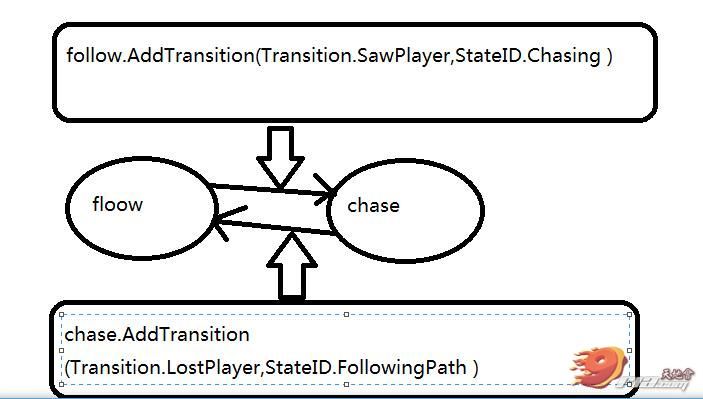或许广大程序员之前接触过游戏状态机,这已不是个新鲜的词汇了。其重要性我也不必多说了,但今天我要讲到的一个状态机框架或许您以前并未遇到过。所以,我觉得有必要将自己的心得分享一下。下面是一个链接:
http://wiki.unity3d.com/index.php/Finite_State_Machine。
接下来我所要讲的就是基于此状态机框架。首先声明一下,这个状态机框架并不是我写的(我现在还没这个能力呢!),我只是想分享从中得到的一点点感悟,仅此而已。好了,我们开始吧!
首先从此链接上映入眼帘的是两个脚本加一个例子,由于是全英文的,估计大部分人不愿意碰这玩意,没办法,这就是瓶颈。如果你想更进一步的必须得越过这道坎,这就是核心竞争力!不过现在你不读也行,因为我会一步一步为您解刨这个状态机系统的。我想我这是帮人还是害人呢?您认为呢?脚本如下:
using UnityEngine; using System.Collections; using System.Collections.Generic; public enum Transition { //定义了一个Transition(转换)类型的枚举变量,所以我们接下来要根据实际情况扩展此枚举变量。 NullTransition = 0, } public enum StateID { //定义了一个StateId(状态ID)类型的枚举变量,所以我们接下来也要根据实际情况扩展此枚举变量。 NullStateID = 0, } public abstract class FSMState//抽象类,我们必须继承它才可以在脚本中实例化并使用它 { protected Dictionary<Transition, StateID> map = new Dictionary<Transition, StateID>(); /*这个成员变量是一个Dictionary类型,就相当于java中的Map类型,存储的是一个个的关联对。此刻我们存储的关联对类型就是上面我们定义的连个枚举类型。那么接下来我们猜也能才出来我们一定会向其添加关联对,可能还会移除此关联对。那么这个东西的用处我们现在还是很迷茫,不要紧,继续向下看吧!没问题的。*/ protected StateID stateID; public StateID ID { get { return stateID; } } public void AddTransition(Transition trans, StateID id)//增加关联对(转换,状态ID) { // Check if anyone of the args is invalid if (trans == Transition.NullTransition)//如果增加的转换是个NullTransition(空转换),直接Debug.LogError,然后返回 { Debug.LogError("FSMState ERROR: NullTransition is not allowed for a real transition"); return; } if (id == StateID.NullStateID)//如果状态ID是NullStateID(空状态ID),怎么办?还是Debug.LoError,然后返回 { Debug.LogError("FSMState ERROR: NullStateID is not allowed for a real ID"); return; } if (map.ContainsKey(trans))//如果将要增加的关联对是之前就存在与关联容器中,也照样Debug.LogError,之后返回被调用处 { Debug.LogError("FSMState ERROR: State " + stateID.ToString() + " already has transition " + trans.ToString() + "Impossible to assign to another state"); return; } map.Add(trans, id);//冲破了这些阻碍的话,终归可以添加此关联对了,下面的DeleteTransition函数就不用我写注释了吧! } public void DeleteTransition(Transition trans)//删除关联对函数,前提是里面要有这个关联对啊! { if (trans == Transition.NullTransition) { Debug.LogError("FSMState ERROR: NullTransition is not allowed"); return; } if (map.ContainsKey(trans)) { map.Remove(trans); return; } Debug.LogError("FSMState ERROR: Transition " + trans.ToString() + " passed to " + stateID.ToString() + " was not on the state's transition list"); } public StateID GetOutputState(Transition trans)//此函数由下面这个脚本FSMSystem.cs中的PerformTransition函数调用。是用来检索状态的。 { if (map.ContainsKey(trans)) { return map[trans]; } return StateID.NullStateID; } public virtual void DoBeforeEntering() { }//从名字就可以看出它的作用是什么,但是我们得在FSMSystem.cs中得到答案。 public virtual void DoBeforeLeaving() { } public abstract void Reason(GameObject player, GameObject npc); /*这个函数与下面这个函数是这个类中最重要的函数。Reason函数负责监听环境条件的改变并触发相应的事件转换。Act函数的作用在于表现当前状态下NPC的行为。我们得在这个抽象类的子类中覆写这两个方法。 */ public abstract void Act(GameObject player, GameObject npc); }
using UnityEngine; using System.Collections; using System.Collections.Generic; public class FSMSystem { private List<FSMState> states;//此类中植入一个类型为FSMState的List容器 // The only way one can change the state of the FSM is by performing a transition //唯一你可以改变FSM中的状态的方法是事先一个转换,这样讲估计有点难以理解,不过我会通过例子来讲解的。 // Don't change the CurrentState directly 不要直接修改CurrentState的值。 private StateID currentStateID ; public StateID CurrentStateID { get { return currentStateID; } }//记住,不要直接修改这个变量,之所以让他公有是因为得让其他脚本调用这个变量。 private FSMState currentState;//记录当前状态 public FSMState CurrentState { get { return currentState; } }//同上 public FSMSystem() { states = new List<FSMState>();//实例化states。 } public void AddState(FSMState s)//增加状态转换对 { if (s == null) { Debug.LogError("FSM ERROR: Null reference is not allowed"); } if (states.Count == 0)
/*第一次添加时必定执行这块代码,因为一开始states是空的,并且这块代码设置了第一次添加的状态是默认的当前状态。这一点读者一定要理解,不然对于后面的东西读者会非常困惑的,因为其他地方没有地方设置运行后默认的当前状态。*/ { states.Add(s); currentState = s; currentStateID = s.ID;//这里实例化了这两个成员变量 return; } foreach (FSMState state in states)//排除相同的状态 { if (state.ID == s.ID) { Debug.LogError("FSM ERROR: Impossible to add state " + s.ID.ToString() + " because state has already been added"); return; } } states.Add(s);//这一句代码第一次不执行,因为第一次states是空的,执行到上面的if里面后立即返回了 } public void DeleteState(StateID id)//跟据ID来从容器states中定向移除FSMState实例 { if (id == StateID.NullStateID) { Debug.LogError("FSM ERROR: NullStateID is not allowed for a real state"); return; } foreach (FSMState state in states) { if (state.ID == id) { states.Remove(state); return; } } Debug.LogError("FSM ERROR: Impossible to delete state " + id.ToString() + ". It was not on the list of states"); } public void PerformTransition(Transition trans)//执行转换 { if (trans == Transition.NullTransition) { Debug.LogError("FSM ERROR: NullTransition is not allowed for a real transition"); } // Check if the currentState has the transition passed as argument StateID id = currentState.GetOutputState(trans);//这下我们得回到当初我所说讲到的FSMState.cs中的那个检索状态的函数。如果检索不出来,就返回NullStateId,即执行下面if语句。 if (id == StateID.NullStateID) { Debug.LogError("FSM ERROR: State " + currentStateID.ToString() + " does not have a target state " + " for transition " + trans.ToString()); return; } currentStateID = id;//还是那句话,如果查到了有这个状态,那么我们就将其赋值给成员变量currentStateID。 foreach (FSMState state in states)//遍历此状态容器 { if (state.ID == currentStateID) { currentState.DoBeforeLeaving();//我们在转换之前或许要做点什么吧!,所以我们如有需要,得在FSMState实现类中覆写一下这个方法 currentState = state;//好了,做完了转换之前的预备工作(DoBeforeLeaving),是时候该转换状态了 currentState.DoBeforeEntering();//状态转换完成之后,有可能得先为新状态做点事吧,那么我们也得DoBeforeEntering函数 break; } } } }
我想大家对此脚本已有了一定的理解了,但是估计还不知道怎么用吧!我给的链接上有一个Example例子,但是光看这个要想想熟练运用这个状态机系统确实得花一番心思。所以我来一步一步地解剖这个例子:
using System; using System.Collections.Generic; using System.Text; using UnityEngine; [RequireComponent(typeof(Rigidbody))] public class NPCControl : MonoBehaviour { public GameObject player;//主角 public Transform[] path;//多个寻路点 private FSMSystem fsm;//内置一个fsm public void SetTransition(Transition t) //转换状态 { fsm.PerformTransition(t); } public void Start() { MakeFSM();//首先初始化状态机,执行MakeFSM函数 } public void FixedUpdate()//作为驱动源 { fsm.CurrentState.Reason(player, gameObject);//定期(默认是0.02秒,在Edit->rojectSetting->Time中可以发现)调用当前FSMState中的Reason函数,用以检测外界环境是否发生变化,并且根据发生的变化来执行某些事件 fsm.CurrentState.Act(player, gameObject);//定期执行当前状态下的某些行为 } // The NPC has two states: FollowPath and ChasePlayer // If it's on the first state and SawPlayer transition is fired, it changes to ChasePlayer // If it's on ChasePlayerState and LostPlayer transition is fired, it returns to FollowPath private void MakeFSM() { FollowPathState follow = new FollowPathState(path);//定义并实例化FSMState follow.AddTransition(Transition.SawPlayer, StateID.ChasingPlayer);//向其添加转换对 ChasePlayerState chase = new ChasePlayerState(); chase.AddTransition(Transition.LostPlayer, StateID.FollowingPath); //我画一张图,你们就明白了这句话了:

那个实心的箭头代表的代码就是上面圆角矩形里面的代码。看了之后我们因该明白了那两句代码的现实意义了吧!即定义转换,也就是floow状态可以与chase互相转换,如果我们填充的状态中出现了别的状态比如说:state0,此时状态floow就不能转换到state0了,同样state0也无法转换到floow。
***************************************************
fsm = new FSMSystem();//实例化fsm fsm.AddState(follow);//将follow装载到fsm中 fsm.AddState(chase);//将chase装载到fsm中 } } public class FollowPathState : FSMState /*继承抽象类FSMState,但是得注意一点:我们得在抽象类FSMState脚本中的两个枚举变量分别加入对应的枚举变量,比如在Transition中加入SawPlayer,LostPlayer;在StateID中加入ChasingPlayer,FollowingPath。*/ { private int currentWayPoint; private Transform[] waypoints; public FollowPathState(Transform[] wp) { waypoints = wp; currentWayPoint = 0; stateID = StateID.FollowingPath; } public override void Reason(GameObject player, GameObject npc) { // If the Player passes less than 15 meters away in front of the NPC RaycastHit hit; if (Physics.Raycast(npc.transform.position, npc.transform.forward, out hit, 15F)) { if (hit.transform.gameObject.tag == "player") npc.GetComponent<NPCControl>().SetTransition(Transition.SawPlayer);//当射线射到的物体的标签为Player时,触发转换。 } } public override void Act(GameObject player, GameObject npc)//当NPC当前状态为follow时不断执行以下行为。下面那个类的用法也是一样的。 { // Follow the path of waypoints // Find the direction of the current way point Vector3 vel = npc.rigidbody.velocity; Vector3 moveDir = waypoints[currentWayPoint].position - npc.transform.position; if (moveDir.magnitude < 1) { currentWayPoint++; if (currentWayPoint >= waypoints.Length) { currentWayPoint = 0; } } else { vel = moveDir.normalized * 10; // Rotate towards the waypoint npc.transform.rotation = Quaternion.Slerp(npc.transform.rotation, Quaternion.LookRotation(moveDir), 5 * Time.deltaTime); npc.transform.eulerAngles = new Vector3(0, npc.transform.eulerAngles.y, 0); } // Apply the Velocity npc.rigidbody.velocity = vel; } } // FollowPathState public class ChasePlayerState : FSMState//同上。 { public ChasePlayerState() { stateID = StateID.ChasingPlayer; } public override void Reason(GameObject player, GameObject npc) { // If the player has gone 30 meters away from the NPC, fire LostPlayer transition if (Vector3.Distance(npc.transform.position, player.transform.position) >= 30) npc.GetComponent<NPCControl>().SetTransition(Transition.LostPlayer); } public override void Act(GameObject player, GameObject npc) { // Follow the path of waypoints // Find the direction of the player Vector3 vel = npc.rigidbody.velocity; Vector3 moveDir = player.transform.position - npc.transform.position; // Rotate towards the waypoint npc.transform.rotation = Quaternion.Slerp(npc.transform.rotation, Quaternion.LookRotation(moveDir), 5 * Time.deltaTime); npc.transform.eulerAngles = new Vector3(0, npc.transform.eulerAngles.y, 0); vel = moveDir.normalized * 10; // Apply the new Velocity npc.rigidbody.velocity = vel; } }
我来总结一下,此状态机框架的用法如下:首先我们得填充抽象类FSMState中的两个枚举类型,然后针对具体情况继承此抽象类并设计脚本,且脚本中必须有一个FSMSystem类型成员变量(可以仿照上面的例子),并且要在Update或FIxedUpdate等函数中不断驱动此状态机运行。且首先我们得用一些FSMState实例来装载此状态机系统实例。而且我们得对每一个FSMState实例添加转换对,控制该状态转换的方向。最后在每个FSMState子类中覆写Reson与Act函数。其中Reson是监听外界条件变化的并且执行某些转换,而Act是表现当前状态行为的函数。
了解了这些,你还觉得自己不会用这个FSMSystem吗?多用用就好了,下次见!
原文链接:http://www.narkii.com/club/thread-272375-1.html